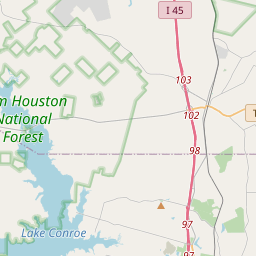St. Joseph's Catholic Church
Historical marker location:






The Rev. Felix Orzechowski, who came to Texas in 1866 to answer an appeal for Polish missionaries, organized St. Joseph's Parish in 1869. The first Catholic church in Walker County, it served the many Polish families who settled this area in the 1870s. Church tradition often sustained the immigrants until they adjusted to life in a new country. Services were held outdoors or in private homes during Father Orzechowski's pastorate. Soon after leaving this parish in 1876, he returned to Poland and was imprisoned by ruling Russian officials for advocating democratic ideals.
A frame church building was erected in 1877 under the direction of the Rev. Victor Justiana Linicki, who was a Polish baron before he became a priest. A larger edifice, designed by Tom Lavandoski, was built in 1897, and the original structure was used as a school. The present church was begun in 1905 and dedicated on the feast of St. Joseph, March 19, 1908, during the pastorate of the Rev. Thomas Aloysius Bily (1859-1921). The stately Gothic-style structure, designed by L.S. Green, reflects the European heritage of the parishioners.
The parish school was operated until 1951. St. Joseph's Catholic Church continues to minister to descendants of New Waverly's historic Polish community.
Recorded Texas Historic Landmark - 1975
As one of the most visible programs of the Texas Historical Commission (THC), historical markers commemorate diverse topics in Texas history, including: the history and architecture of houses, commercial and public buildings, religious congregations, and military sites; events that changed the course of local and state history; and individuals who have made lasting contributions to the state, community organizations, and businesses.
The state of Texas was once an independent country known as the Republic of Texas. It gained independence from Mexico in 1836 and was a separate nation until it was annexed by the United States in 1845.
In 1836, Walker County was officially established and named after Samuel Hamilton Walker, a Texas Ranger captain who died in the Mexican-American War. The county became a hub for trade and commerce, with the town of Huntsville serving as the county seat. The early residents engaged in farming, ranching, and timber industries, which became the backbone of the local economy.
During the Civil War, Walker County played a significant role as a major supplier of food and provisions to the Confederate army. However, the county also faced its share of hardships, including raids by Union troops and the devastation caused by the war. After the war, Walker County experienced a period of reconstruction and gradual recovery.
In the late 19th and early 20th centuries, Walker County saw significant progress and development. The expansion of railroads brought new opportunities for trade and transportation, and the discovery of oil in the early 1900s further boosted the local economy. In recent decades, Walker County has continued to grow and evolve, embracing modern industries while preserving its unique heritage and natural beauty. Today, the county is known for its thriving educational institutions, correctional facilities, and vibrant community.
Walker County Timeline
This timeline provides a concise overview of the key events in the history of Walker County, Texas.
- 1836: Walker County is established
- 1846: Huntsville becomes the county seat
- 1861: Walker County residents vote for secession from the Union
- 1870: The Houston and Great Northern Railroad reaches Huntsville
- 1900: The town of New Waverly is incorporated
- 1936: Sam Houston State Teachers College is established
- 1965: The Texas Department of Corrections is established in Huntsville
- 1970: San Jacinto Mall opens in Baytown
- 1999: The City of Huntsville celebrates its 150th anniversary
- 2007: The Texas Department of Criminal Justice moves its headquarters to Huntsville